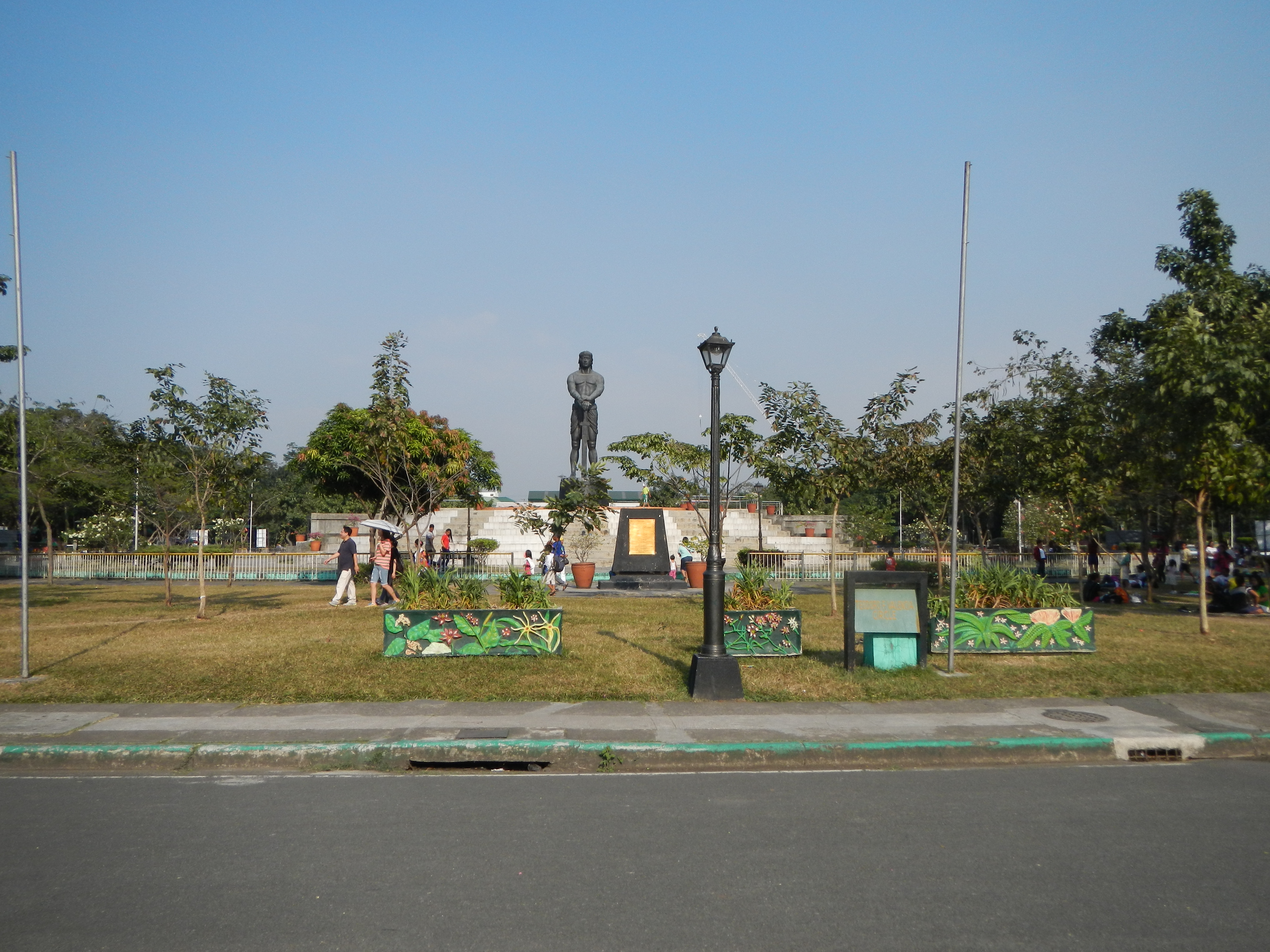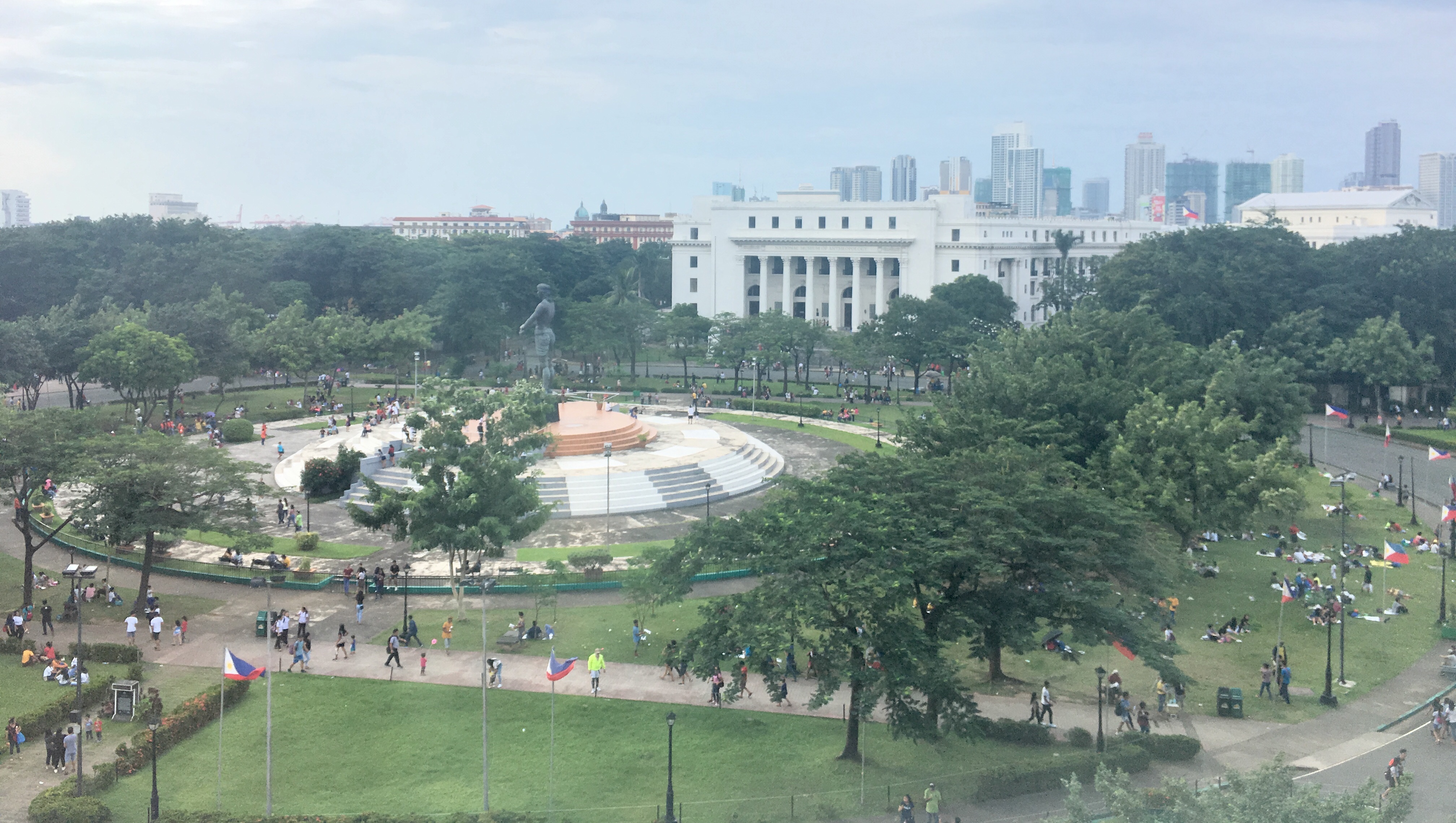Sentinel of Freedom on:
[Wikipedia]
[Google]
[Amazon]
The Statue of the Sentinel of Freedom or the Lapu Lapu Monument is a monument to

 In 2004, House of Representatives members
In 2004, House of Representatives members
Lapulapu
Lapulapu or Lapu-Lapu (ᜎᜉ̰-ᜎᜉ̰), whose name was first recorded as Çilapulapu, was a datu (chief) of Mactan in the Visayas in the Philippines. He is best known for the Battle of Mactan that happened at dawn on April 27, 1521, where ...
located at Rizal Park
Rizal Park ( fil, Liwasang Rizal, es, link=no, Parque Rizal), also known as Luneta Park or simply Luneta, is a historic urban park located in Ermita, Manila. It is considered one of the largest urban parks in the Philippines, covering an are ...
specifically at the center of the Agrifina Circle
The Agrifina Circle, officially the Teodoro F. Valencia Circle, is a traffic circle within the eastern portion of Rizal Park in Manila, the Philippines.
Etymology
The name "Agrifina" is a portmanteau of the words "Agriculture" and "Finance" sinc ...
.
History
 In 2004, House of Representatives members
In 2004, House of Representatives members Raul del Mar
Raul Veloso del Mar (March 20, 1941 – November 16, 2020) was a Filipino politician who served as the Representative of Cebu City's 1st district three times: from 1987 to 1998, from 2001 to 2010, and from 2013 until his death in 2020.
He wa ...
and Nerissa Corazon Soon-Ruiz
Nerissa Corazon Soon-Ruiz (born October 31, 1956) is a Filipino politician who currently serves as City Councilor of Mandaue since 2019.
Life
Soon-Ruiz was born on October 31, 1956 in Mandaue, Cebu, where she still resides to this day. She too ...
initiated the installation of a statue of Lapulapu
Lapulapu or Lapu-Lapu (ᜎᜉ̰-ᜎᜉ̰), whose name was first recorded as Çilapulapu, was a datu (chief) of Mactan in the Visayas in the Philippines. He is best known for the Battle of Mactan that happened at dawn on April 27, 1521, where ...
in Rizal Park as a move to honor Lapulapu as a hero of not only Cebu
Cebu (; ceb, Sugbo), officially the Province of Cebu ( ceb, Lalawigan sa Sugbo; tl, Lalawigan ng Cebu; hil, Kapuroan sang Sugbo), is a province of the Philippines located in the Central Visayas region, and consists of a main island and 16 ...
but the whole Philippines. They urged the Office of the President to an accept their proposal. Then-tourism Secretary Richard Gordon, who was a candidate in the 2004 Senate elections, supported the installation of the statue. The project was opposed by the National Historical Institute
The National Historical Commission of the Philippines ( fil, Pambansang Komisyong Pangkasaysayan ng Pilipinas, abbreviated NHCP) is a government agency of the Philippines. Its mission is "the promotion of Philippine history and cultural heritag ...
(NHI) led by Ambeth Ocampo
Ambeth R. Ocampo (born 1961 in Manila) is a Filipino public historian, academic, cultural administrator, journalist, author, and independent curator. He is best known for his definitive writings about Philippines' national hero José Rizal and o ...
, which insist that only statues of heroes of the Philippine Revolution could be stand in the Agrifina Circle
The Agrifina Circle, officially the Teodoro F. Valencia Circle, is a traffic circle within the eastern portion of Rizal Park in Manila, the Philippines.
Etymology
The name "Agrifina" is a portmanteau of the words "Agriculture" and "Finance" sinc ...
.
The statue was unveiled on February 5, 2004 despite opposition from the NHI, after then President Gloria Macapagal Arroyo
Maria Gloria Macaraeg Macapagal Arroyo (, born April 5, 1947), often referred to by her initials GMA, is a Filipino academic and politician serving as one of the House Deputy Speakers since 2022, and previously from 2016 to 2017. She previously ...
greenlit the move. The Korean Freedom League led by Chairman Kwon Jung-dal donated for the casting of the statue. The statue was momentarily dismantled from the Agrifina Circle sometime in mid-2004, which was met with opposition including the local government of Lapu-Lapu City
Lapu-Lapu City, officially the City of Lapu-Lapu ( ceb, Dakbayan sa Lapu-Lapu; fil, Lungsod ng Lapu-Lapu), is a 1st class highly urbanized city in the Central Visayas region of the Philippines. According to the 2020 census, it has a populatio ...
at that time.
In 2014, Lapu-Lapu City
Lapu-Lapu City, officially the City of Lapu-Lapu ( ceb, Dakbayan sa Lapu-Lapu; fil, Lungsod ng Lapu-Lapu), is a 1st class highly urbanized city in the Central Visayas region of the Philippines. According to the 2020 census, it has a populatio ...
Mayor Paz Radaza requested the transfer of the statue to Punta Engaño of her city where she plans to put it in an island to be made at the tip of the locality. This proposal came up after Radaza talked to Tourism Secretary Ramon Jimenez, Jr. where the National Historical Institute
The National Historical Commission of the Philippines ( fil, Pambansang Komisyong Pangkasaysayan ng Pilipinas, abbreviated NHCP) is a government agency of the Philippines. Its mission is "the promotion of Philippine history and cultural heritag ...
's (NHI) opinion that the statue could "desecrate" Rizal Park was brought up. The move was opposed by Raul del Mar who said that the move would be detrimental and will cause a “loss of honor and recognition” to the province and Cebu and Lapu-Lapu.
Design and symbolism
The Statue of the Sentinel of Freedom and was designed by sculptor Juan Sajid Imao. The monument is composed of a bronze statue on-top of a pedestal. Imao noted that his work on the statue seeks to portray Lapulapu as a strong and peace-loving man who is also ready to defend himself against those who threaten his freedom. Lapulapu is portrayed not in a fighting stance but rather standing guard holding akampilan
The kampilan (Baybayin: ) also known as talong is a type of single-edged sword, traditionally used by various ethnic groups in the Philippine archipelago. It has a distinct profile, with the tapered blade being much broader and thinner at the po ...
covered in scabbard
A scabbard is a sheath for holding a sword, knife, or other large blade. As well, rifles may be stored in a scabbard by horse riders. Military cavalry and cowboys had scabbards for their saddle ring carbine rifles and lever-action rifles on the ...
and planted on the ground.
Then Tourism Undersecretary Oscar Palabyab chose to create a statue for Lapulapu not primarily due to his victory over Ferdinand Magellan
Ferdinand Magellan ( or ; pt, Fernão de Magalhães, ; es, link=no, Fernando de Magallanes, ; 4 February 1480 – 27 April 1521) was a Portuguese explorer. He is best known for having planned and led the 1519 Spanish expedition to the Eas ...
but the value he stands for in history.
The distance between the statue and the Rizal Monument
The Rizal Monument (original title: ''Motto Stella''; Latin: "guiding star") is a memorial in Rizal Park in Manila, Philippines built to commemorate the executed Filipino nationalist, José Rizal. The monument consists of a standing bronze sculpt ...
which is dedicated to Jose Rizal
Jose is the English transliteration of the Hebrew and Aramaic name ''Yose'', which is etymologically linked to ''Yosef'' or Joseph. The name was popular during the Mishnaic and Talmudic periods.
* Jose ben Abin
* Jose ben Akabya
*Jose the Gali ...
is which represents the "400-year gap" between Lapulapu and Rizal. According to Gordon, the Lapulapu represents the Muslims and Rizal represents the Tagalog-Christians in Philippine history.
The statue which was also donated by the Korean Freedom League was a gift in recognition for Filipinos who fought for South Korea
South Korea, officially the Republic of Korea (ROK), is a country in East Asia, constituting the southern part of the Korean Peninsula and sharing a land border with North Korea. Its western border is formed by the Yellow Sea, while its eas ...
in the Korean War
, date = {{Ubl, 25 June 1950 – 27 July 1953 (''de facto'')({{Age in years, months, weeks and days, month1=6, day1=25, year1=1950, month2=7, day2=27, year2=1953), 25 June 1950 – present (''de jure'')({{Age in years, months, weeks a ...
.
See also
* Lapu-Lapu ShrineReferences
{{Manila attractions Monuments and memorials in Metro Manila Buildings and structures in Ermita